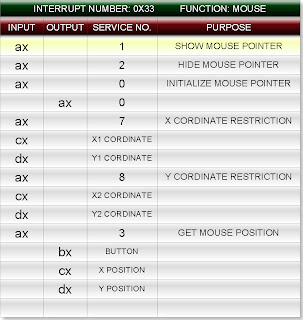Important structure and union:
1. struct BYTEREGS {
Now look at the first row of interrupt table. To show the mouse pointer assign ax equal to 1 i.e. service number while ax is define in the WORDREGS
struct WORDREGS {
REGS i, o;
To access the ax write i.x.ax (We are using structure variable i because ax is input
So to show mouse pointer assign the value of service number to it:
i.x.ax=1;
To provide this information to microprocessor
we use int86 function. It has three parameters
1. Interrupt number i.e. 0x33
The header file dos.h defines two important structures and one union. They are:
1. struct BYTEREGS {
unsigned char al, ah, bl, bh;
unsigned char cl, ch, dl, dh;
};
2. struct WORDREGS {
unsigned int ax, bx, cx, dx;
unsigned int si, di, cflag, flags;
};
3. union REGS {
struct WORDREGS x;
struct BYTEREGS h;
};
Note: Try to remember above structures and union.
There is also one very important function int86 () which has been defined in dos.h header file. It is general 8086 software interrupt interface. It will better to explain it by an example.
Write a c program to display mouse pointer?
Answer:
#include
Write a c program to display mouse pointer?
Answer:
#include
#include
void main()
{
union REGS i,o;
i.x.ax=1;
int86(0x33,&i,&o);
getch();
}
Explanation: To write such program you must have one interrupt table. Following table is only small part of interrupt table.
This table consists for column. They are:
(1) Input
(2) Output
(3) Service number
(4) Purpose
Now look at the first row of interrupt table. To show the mouse pointer assign ax equal to 1 i.e. service number while ax is define in the WORDREGS
struct WORDREGS {
unsigned int ax, bx, cx, dx;
unsigned int si, di, cflag, flags;
};
And WORDRGS is define in the union REGS
union REGS {
struct WORDREGS x;
struct BYTEREGS h;
};
So to access the structure member ax first declare a variable of REGS i.e.
REGS i, o;
Note: We generally use i for input and o for output
To access the ax write i.x.ax (We are using structure variable i because ax is input
(See in the interrupt table)
So to show mouse pointer assign the value of service number to it:
i.x.ax=1;
To provide this information to microprocessor
we use int86 function. It has three parameters
1. Interrupt number i.e. 0x33
2. union REGS *inputregiste i.e. &i
3. union REGS *outputregiste i.e. &o;
So write: int86 (0x33, &i, &o);
0 comments:
Post a Comment